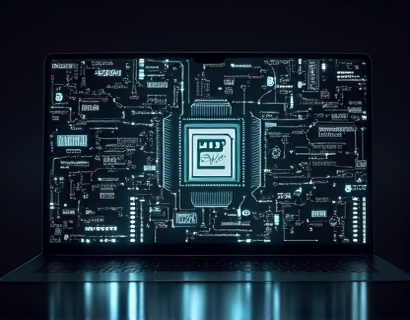Transforming Digital Engagement: The Synergy of AI and Cryptocurrency
The intersection of artificial intelligence (AI) and cryptocurrency is redefining the landscape of digital engagement. This convergence is not just a technological curiosity but a powerful force that is revolutionizing how businesses interact with users, drive growth, and maintain a competitive edge. As we delve into this topic, it's essential to understand the fundamental roles that AI and cryptocurrency play individually and how their integration creates a synergy that amplifies their potential.
Understanding AI in Digital Ecosystems
Artificial intelligence, a subset of computer science, focuses on creating systems that can perform tasks requiring human intelligence, such as learning, reasoning, and self-correction. In the context of digital ecosystems, AI serves as a catalyst for enhancing user experiences, optimizing operations, and uncovering valuable insights. AI-driven solutions can analyze vast amounts of data to identify patterns, predict user behavior, and personalize content, making interactions more relevant and engaging.
One of the key applications of AI in digital ecosystems is in customer service. Chatbots and virtual assistants powered by AI can provide 24/7 support, handle a high volume of queries, and offer instant responses, significantly improving user satisfaction. These AI-driven tools can understand natural language, learn from interactions, and adapt to user preferences, making them invaluable assets for any digital platform.
Cryptocurrency: A New Paradigm for Digital Transactions
Cryptocurrency, on the other hand, represents a decentralized and secure form of digital currency. Built on blockchain technology, cryptocurrencies like Bitcoin, Ethereum, and others offer a transparent, tamper-proof ledger for transactions. This technology has the potential to disrupt traditional financial systems by providing faster, cheaper, and more secure payment methods. Beyond finance, cryptocurrencies are opening new avenues for digital engagement, enabling new forms of value exchange and ownership.
The decentralized nature of cryptocurrencies aligns well with the principles of digital ecosystems, where data and value are distributed across a network of participants. This alignment creates opportunities for innovative applications, such as decentralized finance (DeFi), non-fungible tokens (NFTs), and smart contracts, which can enhance user interactions and create new revenue streams.
AI-Driven Personalization in Cryptocurrency Ecosystems
The combination of AI and cryptocurrency can lead to highly personalized user experiences. AI algorithms can analyze user behavior, preferences, and transaction patterns to offer tailored recommendations and services. For instance, a cryptocurrency exchange can use AI to suggest optimal trading strategies based on a user's historical data and market trends, enhancing the user's investment decision-making process.
Personalization extends beyond trading advice. AI can curate content and notifications that are most relevant to each user, ensuring that they receive timely and useful information. This level of personalization not only improves user satisfaction but also increases engagement and retention, critical factors for the success of any digital platform.
Enhancing Security with AI and Blockchain
Security is a paramount concern in both AI and cryptocurrency domains. The integration of AI with blockchain technology can significantly enhance security measures. AI can detect anomalies and potential threats in real-time, providing a proactive defense against cyber attacks. Machine learning models trained on historical data can identify patterns indicative of fraudulent activities, allowing for swift action to protect user assets.
Blockchain's inherent security features, such as immutability and transparency, complement AI's analytical capabilities. Together, they create a robust framework for secure transactions and data management. For digital ecosystems, this means users can trust the platform to safeguard their information and assets, fostering greater confidence and usage.
Optimizing Operations with AI and Smart Contracts
AI and smart contracts can revolutionize the operational aspects of digital ecosystems. Smart contracts, self-executing contracts with the terms directly written into code, can automate various processes, reducing the need for intermediaries and lowering costs. AI can optimize these smart contracts by analyzing data to determine the most efficient execution parameters, ensuring that transactions are processed smoothly and efficiently.
In the context of decentralized applications (dApps), AI can enhance the functionality and user experience. For example, AI-driven oracles can provide reliable and up-to-date external data to smart contracts, enabling complex operations such as automated insurance claims or decentralized gaming scenarios. This synergy ensures that dApps are not only secure but also highly functional and user-friendly.
Driving Growth through AI and Cryptocurrency
For businesses looking to thrive in the digital age, leveraging the combination of AI and cryptocurrency can be a game-changer. AI-driven insights can help identify new market opportunities and optimize marketing strategies, leading to increased user acquisition and retention. Cryptocurrency, with its potential for decentralized funding and token-based incentives, can provide innovative ways to reward users and stakeholders.
Tokenization, the process of converting assets into tokens on a blockchain, can unlock new revenue streams. For instance, a digital content platform can issue tokens representing access to premium content, creating a new economic model where users can own and trade these tokens. AI can manage and optimize the distribution of these tokens, ensuring fair and transparent reward mechanisms.
Building Trust with Transparency and Accountability
Transparency and accountability are crucial for building trust in digital ecosystems. Blockchain's transparent ledger and AI's ability to provide clear, data-driven insights can work together to create a trustworthy environment. Users can verify transactions and interactions, knowing that the system is free from manipulation. This level of transparency not only enhances user trust but also attracts more participants to the ecosystem.
Moreover, AI can help in maintaining accountability by monitoring and reporting on system performance and user interactions. Automated audits and compliance checks can ensure that the platform adheres to regulatory standards and best practices, further solidifying user confidence.
Future Trends and Innovations
The future of AI and cryptocurrency in digital ecosystems is promising, with several emerging trends and innovations on the horizon. One such trend is the integration of AI with Web3 technologies, which aim to create a more decentralized and user-centric web. AI can enhance Web3 applications by providing intelligent interfaces, personalized experiences, and secure interactions.
Another exciting development is the rise of AI-powered decentralized autonomous organizations (DAOs). These organizations use smart contracts and AI to make collective decisions, manage resources, and execute strategies autonomously. AI can analyze data to inform decision-making processes, ensuring that DAOs operate efficiently and effectively.
Additionally, the convergence of AI and cryptocurrency is likely to see advancements in areas such as AI-driven cryptocurrency trading platforms, AI-enhanced NFT marketplaces, and AI-powered decentralized identity solutions. These innovations will continue to push the boundaries of what is possible in digital engagement, offering new opportunities for businesses and users alike.
Conclusion
The synergy between AI and cryptocurrency is transforming digital engagement in profound ways. By leveraging AI's analytical and personalization capabilities and cryptocurrency's secure and decentralized nature, businesses can create more engaging, secure, and efficient digital ecosystems. As these technologies continue to evolve, the potential for innovation and growth is immense. For tech professionals and enthusiasts, embracing this convergence is essential for staying ahead in the competitive tech landscape and delivering superior user experiences.











































